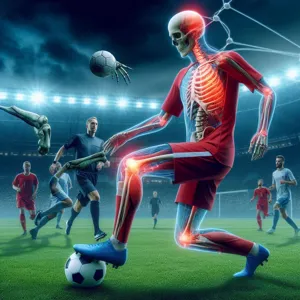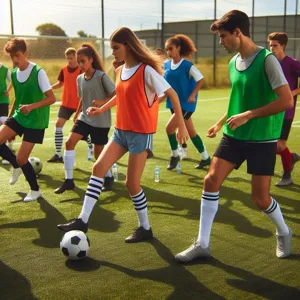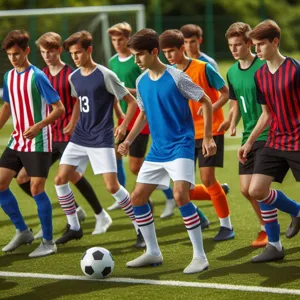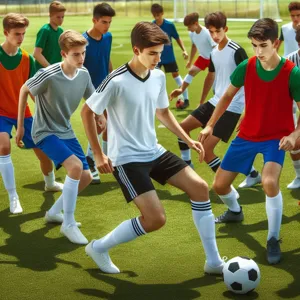When it comes to enjoying a day on the golf course, the right equipment can make all the difference—and that includes your footwear.
The perfect pair of golf shoes not only enhances your performance but also provides the comfort and support needed to tackle 18 holes with ease. However, not all golf shoes are created equal, and finding the right fit is essential for every golfer, regardless of foot shape or size. Whether you have a narrow foot, a wider fit, or require extra cushioning for those long walks from hole to hole, the right golf shoes can elevate your game and your overall experience on the course. In this blog post, we’ll delve into the various foot types and explore the best golf shoe options available, ensuring you find the perfect fit that meets your specific needs. Get ready to step up your game and stride confidently through the fairways!
1. Understanding Different Foot Types

When it comes to selecting the best golf shoes, understanding your foot type is the first step toward ensuring both comfort and performance on the course. Just as every golfer has a unique swing, every foot has its own characteristics that can influence the fit and function of their footwear. Generally, foot types are categorized into three main groups: neutral, pronated, and supinated.
**Neutral Feet**: Those with neutral feet typically have a well-balanced arch that allows for even weight distribution. This foot type does well with a wide variety of golf shoes, particularly those that offer a combination of cushioning and stability. Look for shoes that provide a snug fit around the midfoot while allowing a bit of room in the toe box—this will ensure you maintain comfort during long rounds without sacrificing support.
**Pronated Feet**: If you have pronated feet, your arch tends to collapse inward as you walk, which can lead to overpronation. Golfers with this type of foot should seek shoes designed with extra stability and motion control to help counteract the inward roll. Look for features like medial support, reinforced arches, and a rigid heel counter. These elements will help stabilize your foot, ensuring a solid foundation as you swing.
**Supinated Feet**: Conversely, supinated feet, or under-pronated feet, present a higher arch and often result in insufficient shock absorption. This foot type benefits from shoes that are well-cushioned and offer flexibility to accommodate the natural movement of the foot. When shopping for golf shoes, look for a model with plenty of padding and a soft midsole to provide the necessary support and comfort.
Understanding your foot type is crucial for finding the perfect golf shoes. It not only enhances your comfort but can also improve your overall performance on the course. By investing the time to assess your unique foot characteristics, you can make informed decisions that will keep you playing your best for years to come.
2. Importance of Proper Golf Shoe Fit
When it comes to the game of golf, the importance of proper shoe fit cannot be overstated. Golf is a sport that combines precision, power, and balance, and the foundation of that delicate dance is your footwear. A well-fitting golf shoe plays a critical role in ensuring comfort and stability throughout your swing, allowing you to focus less on your feet and more on your game.
Imagine stepping onto the course, the sun shining, and the anticipation of a great round ahead. However, if your shoes are too tight, too loose, or lacking the right arch support, that excitement can quickly turn into discomfort or even pain. Poorly fitted shoes can lead to blisters, calluses, and long-term foot issues, all of which may hinder your performance and enjoyment of the game.
Proper fit ensures that your feet are securely cradled, allowing for optimal energy transfer as you drive through the ball. A shoe that fits well will provide the necessary traction to navigate uneven terrain and varying lies, helping you maintain balance and power during your swing. On the other hand, shoes that are too loose can cause your foot to slide, increasing the risk of slips and mis-hits, while overly tight shoes can restrict movement and circulation.
Moreover, different foot types—such as high arches, flat feet, or wide feet—require specific features in a golf shoe to provide the best support. For instance, those with high arches might benefit from extra cushioning and arch support, while individuals with flat feet may need a shoe that offers stability and motion control.
In summary, a proper fitting golf shoe is not just a matter of comfort; it’s a crucial component of your overall golf performance. By taking the time to find the right fit, you set yourself up for success on the course, enabling you to play your best game, round after round.
3. Key Features to Look for in Golf Shoes

When it comes to selecting the perfect golf shoes, understanding the key features that enhance your game and provide comfort is paramount. Golf shoes are not just about style; they play a crucial role in your overall performance on the course. Here are some essential features to consider:
**1. Fit and Comfort:** The first and foremost aspect to look for in golf shoes is a proper fit. Shoes should hug your foot snugly without being too tight, allowing for a natural range of motion. Look for options that offer ample cushioning and support to keep your feet comfortable through all 18 holes. A well-designed insole can make a significant difference, especially during long rounds.
**2. Traction and Stability:** The right grip can make or break your swing, which is why traction should be a top priority. Opt for shoes with durable outsoles that feature strategically placed spikes or lugs designed to provide stability during your swing. This will help prevent slipping on the course, ensuring you maintain your balance and power throughout your game.
**3. Waterproofing:** Weather can be unpredictable, and wet conditions can hinder your performance. Choose golf shoes with waterproof materials or a reliable waterproof membrane to keep your feet dry and comfortable, no matter the elements. This feature is particularly important for early morning tee times when dew can linger on the grass.
**4. Breathability:** Golfers can spend several hours on the course, so breathability is essential to keep your feet cool and comfortable. Look for shoes made from breathable materials that allow for airflow, helping to wick away moisture and reduce the risk of blisters and discomfort.
**5. Weight:** Lightweight shoes can significantly enhance your mobility and comfort during a long round. Heavier shoes can feel cumbersome as you walk from hole to hole, while lighter models allow for a more natural gait and can help you maintain your energy levels throughout the day.
By focusing on these key features, you can ensure that your golf shoes not only provide the necessary support and performance enhancements but also deliver comfort and style, keeping you ready to hit the links with confidence, no matter your foot type.
4. Golf Shoe Types: Spiked vs. Spikeless
When it comes to choosing the right golf shoes, one of the most significant decisions you’ll face is whether to opt for spiked or spikeless shoes. Each type offers unique benefits and caters to different preferences and playing styles, making it essential to understand their differences before making a purchase.
**Spiked Golf Shoes** are traditional favorites among many golfers, particularly those who prioritize traction and stability. Featuring rubber or metal spikes on the outsole, these shoes provide excellent grip on the course, especially in wet or uneven conditions. The spikes dig into the turf, preventing slipping during your swing and allowing for more powerful shots. This added stability can be particularly beneficial for players with a more aggressive swing or those who play on hilly courses. However, it’s worth noting that spiked shoes can sometimes feel cumbersome and may not be ideal for walking long distances between holes.
On the other hand, **Spikeless Golf Shoes** have gained enormous popularity in recent years for their versatility and comfort. With a flat outsole that features a tread pattern instead of traditional spikes, these shoes offer a more casual aesthetic, allowing golfers to wear them off the course without feeling out of place. Spikeless shoes provide adequate traction for most courses and offer a lightweight feel that enhances comfort during long rounds. They are particularly favored by players who enjoy walking the course and value the freedom of movement. However, they may not provide the same level of grip on wet grass as their spiked counterparts.
Ultimately, the choice between spiked and spikeless golf shoes boils down to personal preference, playing style, and the specific conditions of the courses you frequent. Whether you prioritize traction or comfort, understanding the differences between these two types will help you find the perfect fit to enhance your game and keep you comfortable on the green.
5. Best Golf Shoes for Flat Feet
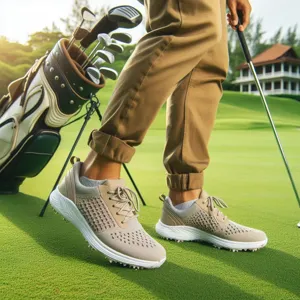
When it comes to finding the best golf shoes for flat feet, comfort and support should be at the top of your priority list. Flat feet, characterized by little to no arch, can lead to discomfort during long rounds on the course if not properly supported. Fortunately, many golf shoe brands have recognized this need and designed models that cater specifically to the unique requirements of flat-footed golfers.
Look for shoes that offer a wide toe box, which allows your feet to spread naturally without feeling cramped. A quality pair should incorporate features like cushioned insoles and a stable heel counter to provide the necessary arch support and prevent overpronation—where the foot rolls inward excessively. Brands such as New Balance and Ecco have made a name for themselves in this category, offering shoes that combine sleek aesthetics with essential support.
Additionally, consider shoes with a flexible upper material, as this will accommodate the natural shape of your foot while providing breathability—keeping your feet cool and dry throughout your game. Waterproof options are also available for those who frequently play in wet conditions, ensuring that your feet remain comfortable no matter the weather.
Some standout models to consider include the New Balance Fresh Foam LinksSL, known for its exceptional cushioning and stability, or the Adidas Tour360 XT, which features a supportive design along with a responsive feel. By choosing the right golf shoes designed for flat feet, you can enhance your performance on the greens while ensuring that comfort is never compromised.
6. Best Golf Shoes for High Arches
When it comes to golfing, having the right footwear can make all the difference, particularly for those with high arches. Golfers with this specific foot type often experience discomfort from standard shoes that lack adequate support, leading to fatigue and potential injury on the course. Therefore, selecting shoes that cater to high arches is crucial for both performance and comfort.
The ideal golf shoes for high arches offer enhanced arch support, cushioning, and stability. A popular choice among golfers is the **FootJoy Pro/SL**. Known for its plush cushioning and excellent arch support, this shoe features a soft leather upper that conforms to the foot, providing both comfort and durability. The supportive insole ensures that your arches are well-supported, allowing for a relaxed swing and a more enjoyable round.
Another excellent option is the **Nike Air Zoom Infinity Tour**. This shoe combines a sleek design with cutting-edge technology, featuring a responsive Zoom Air unit that cushions each step. Its specially designed arch support cradles high arches, promoting a natural gait and reducing strain on the feet. Plus, the traction and stability provided by the outsole ensure that you maintain your footing through every swing, regardless of the terrain.
For those who prefer a spikeless option, the **Adidas CodeChaos** is worth considering. With its unique outsole and Boost midsole technology, this shoe delivers exceptional energy return and comfort. The design includes a supportive upper that helps maintain your foot’s natural arch, allowing for a secure fit without compromising mobility.
When selecting golf shoes for high arches, always look for features such as custom insoles or the ability to accommodate orthotics if needed. Additionally, ensure there’s enough room in the toe box to prevent pinching while providing a locked-in feel at the heel. By choosing the right pair, golfers with high arches can enhance their game, minimizing discomfort and maximizing performance on the green.
7. Best Golf Shoes for Wide Feet

Finding the right golf shoes can be especially challenging for players with wide feet, but rest assured, there are excellent options designed to provide both comfort and performance on the course. When you’re dealing with wider foot dimensions, the last thing you want is to feel constricted or uncomfortable during your swing. The perfect pair should offer ample room in the toe box and across the midfoot, allowing for natural movement and stability as you navigate the greens.
One standout option for wide-footed golfers is the **New Balance Fresh Foam LinksSL**. Renowned for its exceptional cushioning, this shoe features a wide fit and a spikeless outsole that provides excellent traction without sacrificing comfort. The Fresh Foam technology ensures that every step feels light and springy, perfect for those long days on the course.
Another great choice is the **Adidas 4DFWD Sport**. This shoe combines a stylish design with a breathable knit upper that naturally accommodates wider feet. The 4D printed midsole adds a layer of personalized support, ensuring that your feet feel secure and comfortable throughout your swing. Plus, the unique boost technology in the sole provides excellent energy return, keeping you feeling fresh all day long.
If you’re looking for something more classic, the **Ecco Biom Hybrid 3** is a fantastic option. This shoe features a wider fit without compromising on style, offering a sleek leather upper that looks as good off the course as it does on it. The outsole design enhances stability and grip, ensuring that you maintain solid footing during your swing.
Lastly, the **FootJoy Pro/SL** is a favorite among many golfers with wide feet. With its broad fit and plush cushioning, this shoe is designed to provide maximum comfort and support. The spiked sole enhances traction, giving you confidence in your grip, whether you’re teeing off or navigating tricky lies.
When searching for the best golf shoes for wide feet, remember that comfort is paramount. Look for shoes that offer a true wide fit, sufficient cushioning, and a supportive design to ensure you can focus on your game without the distraction of discomfort. By choosing the right pair, you’ll be well on your way to enjoying every round with greater confidence and performance!
8. Best Golf Shoes for Narrow Feet
Finding the right golf shoes can be a game-changer, especially for those with narrow feet who often struggle to find a comfortable and secure fit. When it comes to selecting the best golf shoes for narrow feet, you want to prioritize models that offer a snug fit without compromising on comfort or stability. Here are some top recommendations that cater specifically to narrow-footed golfers.
**1. Adidas Adizero One:** Known for their lightweight design, the Adidas Adizero One features a sleek, streamlined silhouette that hugs the foot perfectly. The shoe incorporates a breathable mesh upper, providing excellent ventilation during those long rounds on the course. Additionally, the Boost cushioning technology offers responsive comfort, making every swing feel effortless.
**2. FootJoy Pro/SL:** A favorite among many golfers, the FootJoy Pro/SL is not only stylish but also engineered for performance. With a narrower fit in the forefoot, these shoes provide great support and stability while maintaining a classic look. The soft, waterproof leather upper keeps your feet dry, while the dual-density cushioning ensures comfort from the first tee to the 18th hole.
**3. Nike Air Zoom Victory:** Designed with the golfer in mind, the Nike Air Zoom Victory utilizes a snug fit that conforms to the shape of your foot. Featuring a lightweight, breathable upper and responsive Zoom Air units for cushioning, these shoes deliver exceptional comfort and traction on the course. The sleek design means you’ll look as good as you feel while sinking those crucial putts.
**4. Ecco Biom Hybrid 3:** For those seeking a blend of style and functionality, the Ecco Biom Hybrid 3 shines with its elegant design and ergonomic shape. The narrow fit, combined with the unique Biom Natural Motion technology, allows for a natural range of motion while providing excellent support. The waterproof leather upper keeps your feet dry, ensuring you stay comfortable in varying weather conditions.
When selecting golf shoes for narrow feet, consider trying them on with the socks you typically wear while playing. Look for options that provide adequate arch support and stability, as these features are essential for maintaining a solid stance throughout your swing. With the right pair of shoes, you’ll not only improve your performance on the course but also enjoy a level of comfort that keeps you focused on your game.
9. The Role of Cushioning and Support
When it comes to finding the perfect pair of golf shoes, the importance of cushioning and support cannot be overstated. Every golfer knows that a game of 18 holes can last several hours, often requiring you to traverse varied terrains, from manicured fairways to uneven rough. The right cushioning and support will not only enhance your comfort but also play a pivotal role in your overall performance on the course.
Cushioning refers to the materials used in the midsole of the shoe that absorb shock and provide a soft landing for your feet. This is especially crucial for golfers who suffer from joint pain or those who simply want to maximize their comfort during play. Look for shoes that feature advanced cushioning technologies, such as EVA foam or gel inserts, which offer a plush feel while maintaining responsiveness. This ensures that with every swing, your feet remain well-supported, reducing fatigue and discomfort.
Support, on the other hand, focuses on the shoe’s ability to stabilize your foot during the swing. Golf involves a unique blend of lateral movement and rotational forces, which places significant demands on your footwear. Shoes with a structured heel counter and a snug fit around the arch provide the necessary support to keep your foot secure, preventing unnecessary movement that could lead to blisters or even injuries.
Additionally, some brands offer specialized features like dual-density foam or carbon fiber plates, which enhance stability without compromising flexibility. For golfers with specific foot types, such as flat feet or high arches, selecting shoes with proper arch support is essential in preventing strain and ensuring a more efficient swing.
In summary, when evaluating golf shoes, pay close attention to the combination of cushioning and support. By choosing a shoe that offers the right balance tailored to your individual needs, you’ll not only improve your comfort but also enhance your overall performance on the course. As you pour your heart into every swing, let your footwear work just as hard to keep you grounded and poised for success.
10. Weather Considerations: Waterproof vs. Breathable
When it comes to choosing the right golf shoes, weather considerations play a pivotal role in your overall comfort and performance on the course. Golf is often played in varying conditions, from sunny skies to unexpected rain showers, making it essential to select a shoe that suits the climate you’ll be playing in.
**Waterproof Shoes:** If you frequently find yourself navigating wet, dewy grass or playing in rainy conditions, investing in waterproof golf shoes is a no-brainer. These shoes are designed with specialized materials and membranes that repel water while allowing moisture to escape from within, keeping your feet dry and comfortable. Look for options with sealed seams and durable water-repellent coatings, which provide an extra layer of protection against the elements. Brands have made significant advancements in waterproof technology, ensuring that you don’t have to sacrifice style for functionality. Many modern waterproof shoes also feature excellent traction, so you can maintain your grip on slippery surfaces.
**Breathable Shoes:** On the other hand, if you’re playing in hot and humid conditions, a breathable shoe is crucial. Breathable golf shoes are crafted with lightweight materials and ventilated designs that allow air to circulate, keeping your feet cool and reducing the risk of perspiration and discomfort. Look for mesh panels or perforated uppers that enhance airflow without compromising support. These shoes are particularly advantageous during the warmer months, as they help prevent overheating and blisters, letting you focus on your swing rather than your discomfort.
Ultimately, the best golf shoes for you will depend on your local climate and personal preferences. Consider your playing environment and how often you encounter wet or hot conditions. By selecting the right footwear, you’ll not only improve your performance on the course but also enhance your overall golfing experience, ensuring that you can play your best, regardless of the weather.
11. Top Brands for Golf Shoes: An Overview
When it comes to golf shoes, the brand you choose can make a significant difference in both comfort and performance on the course. With a myriad of options available, it’s essential to find a brand that aligns with your specific needs. Here’s a rundown of some top brands renowned for their quality, innovation, and style in the world of golf footwear.
**1. FootJoy:** A longstanding favorite among golfers, FootJoy is synonymous with comfort and performance. Their shoes often feature advanced cushioning technology and waterproof materials, making them perfect for all-weather play. FootJoy’s extensive range caters to various foot types, ensuring you find the right fit to enhance your game.
**2. Nike:** Combining cutting-edge technology with sleek aesthetics, Nike golf shoes are designed for the modern golfer. Their innovative designs often incorporate breathable materials and responsive cushioning, providing excellent support throughout your swing. Nike’s commitment to performance and style makes them a popular choice among both amateurs and professionals.
**3. Adidas:** Known for their iconic three stripes, Adidas is a major player in the golf shoe market. Their Boost technology offers exceptional energy return and comfort, making long rounds more enjoyable. Adidas also emphasizes sustainability in their production methods, appealing to environmentally conscious golfers without sacrificing style or performance.
**4. Puma:** If you’re looking to make a fashion statement on the course, Puma is a brand worth considering. Their golf shoes are not only stylish but also packed with technological advancements, such as their Ignite foam for superior comfort and traction. Puma’s playful designs and vibrant colors allow you to express your personality while still maintaining a professional look.
**5. Ecco:** Renowned for their craftsmanship, Ecco golf shoes are designed with the utmost attention to detail. Their natural leather uppers provide a premium feel, while their unique Comfort Fiber System ensures all-day cushioning. Ecco shoes often blend traditional aesthetics with modern performance, making them a favorite among discerning golfers.
**6. Callaway:** While primarily known for their clubs, Callaway has made significant strides in the footwear arena. Their golf shoes are designed with the golfer in mind, featuring features like a waterproof upper, lightweight construction, and excellent traction. Callaway shoes are perfect for those who value performance but don’t want to compromise on style.
Choosing the right brand can significantly influence your golfing experience, so take the time to try on different styles and find the one that feels like a perfect fit. With the right golf shoes, you’ll not only enhance your performance but also enjoy every step on the course.
12. How to Measure Your Foot for the Perfect Fit
Finding the perfect pair of golf shoes begins with understanding the unique shape and size of your feet. Proper measurement is essential, as even slight discrepancies can lead to discomfort on the course. Here’s a step-by-step guide to ensure you get the most accurate measurement possible.
**Step 1: Gather Your Tools**
Before you start, you’ll need a few simple tools: a ruler or measuring tape, a piece of paper, and a pen or pencil. You might also want a friend to help you if possible, but it can be done solo too.
**Step 2: Prepare Your Foot**
It’s best to measure your feet at the end of the day when they are likely to be at their largest. Stand up and place your foot on the piece of paper, ensuring your weight is evenly distributed. This will give you an accurate representation of your foot’s true size.
**Step 3: Trace Your Foot**
using your pen or pencil, carefully trace around your foot, keeping the writing instrument perpendicular to the paper. Make sure to capture the outline of your toes and heel for a precise measurement.
**Step 4: Measure the Length and Width**
After you have your footprint, measure the length from the heel to the longest toe. Next, measure the widest part of the foot to determine its width. It’s important to take both measurements for a complete picture of your foot size.
**Step 5: Consult Size Charts**
With your measurements in hand, refer to the size charts provided by the shoe manufacturer. Each brand may have slightly different sizing, so check the specific chart for the shoes you are considering. Keep in mind that some brands offer wide or narrow options, which can make a significant difference in comfort and fit.
**Step 6: Consider Foot Type**
Your foot type—whether it be neutral, flat, or high-arched—will also influence the fit of your golf shoes. If you have high arches, look for shoes with good arch support, while those with flat feet might benefit from shoes designed for stability.
**Step 7: Try Before You Buy**
If possible, always try on golf shoes before making a purchase. Walk around in them, pay attention to how they feel, and ensure there’s enough room in the toe box as well as around the heel. A well-fitted shoe should feel snug without being tight, providing support without restricting movement.
By taking the time to measure your foot correctly and understanding your specific foot type, you’ll be well on your way to finding the perfect golf shoes that not only enhance your performance but also keep you comfortable throughout your game. Happy golfing!
13. Tips for Trying on Golf Shoes
Choosing the right golf shoes is essential for both comfort and performance on the course, and trying them on correctly can make all the difference. Here are some helpful tips to ensure you find the perfect fit for your unique foot type.
1. **Time It Right**: Always try on golf shoes in the afternoon or evening when your feet are slightly swollen from daily activities. This will give you a more accurate sense of how the shoes will feel during an entire round of golf.
2. **Socks Matter**: Wear the same type of socks that you plan to wear while golfing—preferably golf-specific or athletic socks. This will help you gauge the fit more accurately, as thickness can affect shoe size and comfort.
3. **Heel and Toe Check**: When trying on shoes, make sure your heel fits snugly without slipping. You should have about a thumb’s width of space between your longest toe and the end of the shoe. This ensures that your toes have enough room to wiggle without feeling cramped.
4. **Walk It Out**: Don’t just stand still; walk around the store. Take a few laps to see how the shoes feel during movement. Pay attention to any areas of discomfort, particularly around the arches and the sides of your feet.
5. **Stability Test**: If possible, perform a few practice swings in the shoes. This will help you assess the stability and support they provide, which is crucial for maintaining balance during your swing.
6. **Try Different Brands**: Each brand has its own sizing and design quirks. Don’t hesitate to try on multiple brands and styles to find what works best for your specific foot shape and arch type.
7. **Assess the Material**: Consider the construction of the shoe. Breathable materials are essential for comfort, especially in warmer weather, while waterproof options are ideal for wet conditions. Make sure to evaluate how each shoe feels against your foot’s skin.
8. **Check the Width**: Many brands offer different width options. If you have wider feet, look for shoes labeled as ‘wide’ or ‘extra wide.’ A good fit should feel snug but not tight, allowing for natural foot movement.
By taking these practical steps when trying on golf shoes, you’ll be better equipped to find a pair that not only fits well but also enhances your performance on the golf course. Remember, the right shoes can make a significant difference in your game, helping you stay comfortable and focused on your swing instead of your feet.
14. Maintaining Your Golf Shoes for Longevity
Maintaining your golf shoes for longevity is crucial if you want to enjoy their benefits for many seasons to come. Just like any piece of sporting equipment, proper care can significantly extend the life of your shoes and ensure they perform at their best on the course.
First and foremost, after each round of golf, take a moment to clean your shoes. A soft brush or damp cloth can work wonders for removing dirt, grass, and mud that can accumulate during play. Pay special attention to the soles, as debris can build up and affect your grip on the course. If your shoes are waterproof, a quick rinse with water will help maintain their integrity—just be sure to dry them thoroughly afterward.
Next, consider using a shoe tree or crumpled newspaper to help maintain their shape. This step prevents creasing and keeps your shoes looking fresh. Storing your golf shoes in a cool, dry place away from direct sunlight will also help avoid material degradation and fading.
Another essential aspect of maintenance is checking the cleats. If your golf shoes are equipped with removable spikes, inspect them regularly for wear and tear. Worn-out spikes can compromise your traction, so replacing them promptly is key to maintaining stability during your swing. Even for spikeless shoes, the tread should be monitored; replace them if you notice significant flattening.
Finally, rotating between pairs can also prolong the life of your golf shoes. By giving each pair a chance to rest and recover, you reduce the wear and tear that comes from constant use. This simple practice allows the materials to breathe and return to their original shape, keeping your shoes comfortable and ready for your next round.
By following these maintenance tips, you not only enhance the longevity of your golf shoes but also ensure that they continue to provide the support and performance you need to play your best on the course. A little care goes a long way, and your feet will thank you for it!
15. Conclusion: Choosing the Right Golf Shoe for Enhanced Performance
In conclusion, selecting the right golf shoe is not just a matter of style; it’s a crucial decision that can significantly impact your performance on the course. Each foot type, whether it be neutral, flat, or high-arched, has unique needs that must be addressed to ensure optimal comfort and stability during your swing. As we’ve explored, the right fit provides not only support but also enhances your balance, allowing you to focus on your game rather than discomfort.
When choosing your ideal golf shoe, consider the specific features that cater to your foot type. Look for shoes with appropriate arch support, cushioning, and traction that align with your playing style and the terrain of the courses you frequent. Don’t hesitate to try on multiple pairs, walk around in them, and pay attention to how they feel. Remember, the best golf shoe is one that feels like an extension of your body, enhancing your natural movement rather than restricting it.
Investing time in finding the right pair can lead to improved performance, reduced fatigue, and a more enjoyable golfing experience. So, lace up with confidence, know your foot type, and step out onto the course ready to elevate your game. Happy golfing!
As we wrap up our exploration of the best golf shoes for every foot type, we hope you now have a clearer understanding of how to choose the perfect pair that will enhance your game and keep you comfortable on the course. Whether you have flat feet, high arches, or anything in between, the right golf shoes can make all the difference in your performance and enjoyment. Remember, investing time in finding the ideal fit is just as important as perfecting your swing. So lace up, step onto the green with confidence, and let your new footwear elevate your game. Happy golfing, and may every round bring you closer to that elusive hole-in-one!





















